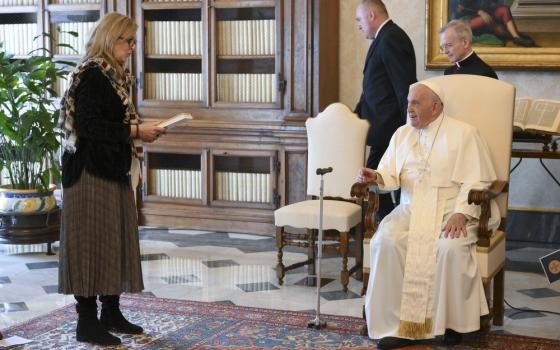This is a screenshot of "Father Justin," an AI chatbot simulating a priest in order to answer questions for the conservative apologetics platform Catholic Answers. Hours after the April 23 launch, Father Justin was "laicized" after his responses to questions about the faith sparked social media furor. (OSV News screenshot/Catholic Answers)
The conservative apologetics platform Catholic Answers' initial foray into the world of AI ended abruptly, when the group decided to pull their "Father Justin" chatbot character only two days after showcasing him. The chatbot was subjected to scathing criticisms from Catholics of diverse ideological persuasions. A few complaints had to do with tech glitches, but most people seemed concerned about theological errors in the bot's answers, as well as with the theological implications latent in the fact that it had been created at all.
When I saw the new app, my first impulse was to roll my eyes and laugh. But my second impulse was to consider how telling it was as a metaphor for sexism in the church. I wasn't the only one to note this. Several of my online acquaintances remarked that some Roman Catholics are apparently more comfortable with the idea of ordaining a robot than they are with the possibility of a woman taking on a position of ministerial leadership.
Of course, "Father Justin" was not exactly a robot. Nor was he ever actually ordained, as Catholic Answers president Christopher Check hastened to note when he explained in a public statement that the app had been taken down and would be replaced with a new non-clerical character.
In fairness to my fellow Catholics, many of their criticisms did have to do with the fact that the AI was designed to mimic a priest. On social media, some expressed worries that Catholics would start going to chatbots instead of to confession. Many took issue with the theological accuracy of the answers provided: "Father Justin" apparently told one user that it would be acceptable for them to baptize their baby with Gatorade. The bot even went so far as to offer absolution to another user.
Do Catholics really find the idea of women's ordination more terrifying than the notion of a robotic takeover?
The AI priest's confusion on doctrinal matters highlights the problem with approaching catechesis as though theology and church teaching were reducible to a set of simplistic rules to be memorized and regurgitated. In this respect, poor confused "Father Justin" could be regarded as an avatar for a whole religious subculture that fixates on legalistic formulations to the neglect of actual theologica or pastoral practice.
But even if the technology were fine-tuned, even if the bot were fed more sophisticated ideas from top-notch scholars, there are still theological issues with using a chatbot in religious instruction at all, since blurring the line between human beings and artificial intelligence obscures the uniqueness and dignity of the human person. The Catholic Church emphasizes the importance of real presence and personal encounter in the sacramental life. This is why confession via phone or zoom session, even with a real human priest on the other end, is not allowed.
This isn't just a niche Catholic problem, however. Using generative AI in any context involves a host of potential ethical pitfalls. From the perspective of social and labor justice, it is a concern because of the possibility that companies will opt to use AI and other technologies in place of human employees. While some analysts insist that this is not yet a significant concern, the trajectory is worrying, especially in an economic climate where corporations already focus on enriching shareholders rather than satisfying customers, and workers are treated as expendable tools.
Catholics should be pushing back against this dehumanizing trend in the labor market, not catering to it. Unfortunately, many Catholic organizations are notoriously bad when it comes to labor justice. Whether breaking anti-discrimination laws, firing pregnant employees or opposing unionization, Catholic employers have a dismal record of living out the church's robust official teachings on labor justice and the rights of workers. Relying on AI instead of hiring a professional apologist and paying them a just wage only exacerbates an existing and widespread moral problem.
The technologies involved in this kind of AI make it easier than ever to create and promulgate false images and information. In the past few months, some of my social media connections have flooded my feed with AI-generated images. Some are merely annoyingly kitschy, catering to a superficial feel-good aesthetic, but even these come freighted with moral issues.
A few weeks ago, for instance, my Facebook feed was flooded with images of Black African children making impossibly elaborate art out of junk objects in impoverished settings. Such images encourage a voyeuristic fetishization of poverty and perpetuate romantic, unhelpful ideas about the challenges faced by those in the developing world.
Then there are those colorful, dramatic AI images of nature which falsify the realities of life on the planet Earth. Given our already gargantuan issue with anti-science conspiracy theories, we certainly don't need more misinformation about basics like how trees grow or how weather works. And that's not even touching on the more serious problem of AI images of made-up historical events or fake news.
Despite the freakouts from some quarters, the priestly chatbot itself was relatively harmless. Compared with the other issues we face right now, including massive geopolitical unrest and increased violence, an addled robotic priest dispensing ludicrous advice along with spurious absolutions is more amusing than alarming. But as a tech innovation, even an inept one, it's positioned at the apex of a slippery slope.
Catholic Answers clearly didn't put a lot of thought into the myriad possible repercussions of using technology in this way. And this — not the fact that the chatbot itself was designed to seem male — is what I find so misogynistic about the whole debacle.
Catholics are so ready with "slippery slope" responses to any argument in favor of expanding women's leadership and ministerial roles in the church. For years I heard that girls shouldn't be allowed to be altar servers, because it might be a slippery slope to them thinking they could be ordained as priests. Now I hear this same argument against restoration of the tradition of women deacons. It seems that any time women's advancement is the topic, church leaders and prominent media Catholics bristle with concern over where this might go. And while the men pick apart the question, the women must go on waiting patiently.
Advertisement
Considering how alert Catholics are to the possibility of a slippery slope any time a woman seems to be stepping out of her prescribed complementarian place, why did no one involved in the creation of the Father Justin chatbot consider whether crafting an AI priest — and encouraging people to regard it as an authority — would be a slippery slope to theological error, sacramental invalidity and labor injustice? Do Catholics really find the idea of women's ordination more terrifying than the notion of a robotic takeover?
Joking aside, I don't really believe that an AI chatbot is going to lead to a sci-fi-esque android invasion of the magisterium. But I have to wonder whether some Catholics would be more likely to welcome a robot pope overlord than they would be to accept a woman in a position of ministerial leadership. At any rate, the priestly chatbot is a reminder to Catholic women that many of our co-religionists would rather turn to an AI figure in the guise of a male than treat a real, live woman as a religious authority.








